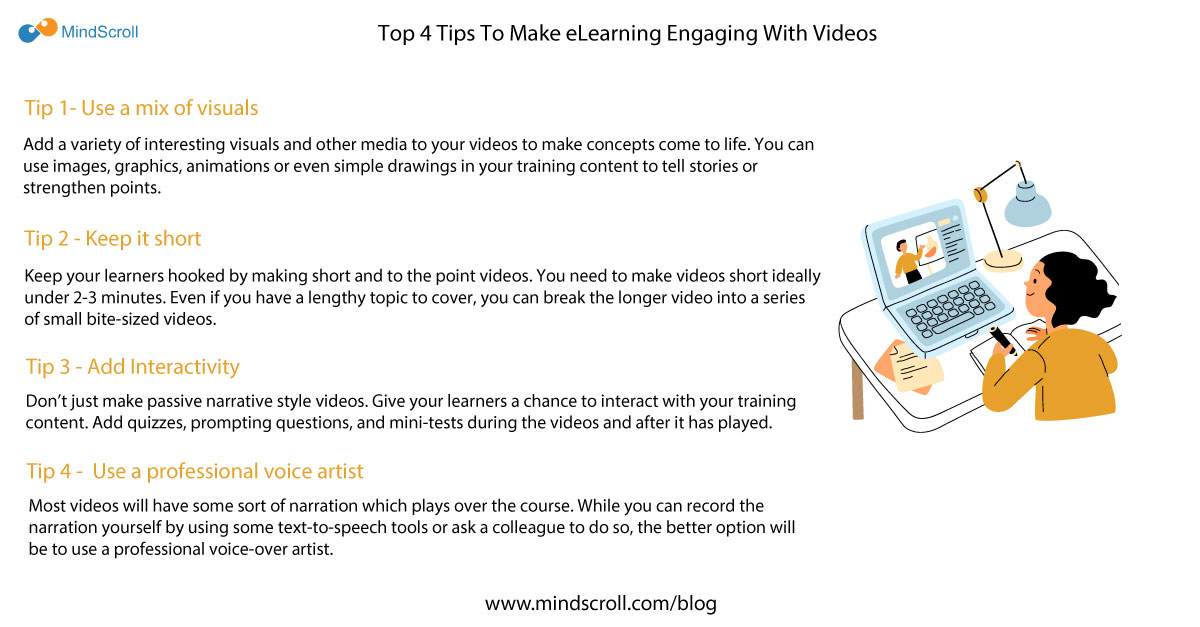Videos are a great way to present content in the online format. They are more memorable, versatile, and engaging than textual content. They allow learners to pause, rewind, and review material, They also tend to quickly grab learners’ attention and can be used for multiple purposes. Plus, people tend to watch videos as they are more engaging than passively reading documents.
Hence, videos are key in making your online training more exciting and effective. Further they make knowledge retention and recall much easier for learners. However, just using videos without a well-thought out strategy won’t be effective. The course must be gripping from the start because if learners lose interest getting them back will be hard. The following tips will ensure that your videos hit the mark.
1. Use a mix of visuals
2. Keep it short
3. Add some interactivity
4. Use a professional voice artist
1. Use a mix of visuals
Add a variety of interesting visuals and other media to your videos to make concepts come to life. You can use images, graphics, animations or even simple drawings in your training content to tell stories or strengthen points. You can also use a selected number of fonts and colors as too many will distract your learners from learning the actual topic. They should be easy to read and contrast well with each other.
Such visually appealing videos illustrate concepts in a highly engaging way and are likely to be watched by learners. It is also important to collect and act on the course and video feedback that you get from learners. This will help you to see the types of visual media that resonate best with your audience and the ways to replicate that success.
2. Keep it short
Keep your learners hooked by making short and to the point videos. Attention span of people has been decreasing since the past couple of years. Long videos are also not very engaging. Therefore, you need to make videos short ideally under 2-3 minutes. Even if you have a lengthy topic to cover, you can break the longer video into a series of small bite-sized videos. You can also include breaks such as quizzes or interactive segments which would not interfere with the flow too much.
Breaking long videos into shorter digestible clips will give your learners an improved sense of progress and achievement. It will let them better plan their time so that they easily complete their training when their busy schedules allow. Further, having the option to save or pause the video will also be helpful. This is because it’s common to have interruptions while learning. Learners also need mental breaks from time to time so having the option to hit the pause or stop button will elevate the overall training experience.
3. Add some interactivity
Don’t just make passive narrative style videos. Give your learners a chance to interact with your training content. This will increase the level of learner engagement and knowledge retention.You can do this by making your videos more interactive by adding quizzes, prompting questions, and mini-tests during the videos and after it has played. You can use open-ended questions rather than recall/close-ended questions as they will be better in prompting engaging discussions and encouraging multiple learner perspectives.
Moreover, you can break up videos with real-world like scenarios which allow learners to participate and pick the right response to that particular situation. Adding such interactivity to your videos will allow your learners to process the content in a more active way other than just watching the content passively.
4. Use a professional voice artist
Most videos will have some sort of narration which plays over the course. While you can record the narration yourself by using some text-to-speech tools or ask a colleague to do so, the better option will be to use a professional voice-over artist. Even if you don’t do the latter, you should still avoid using a monotone or robot-like voice in videos.
However having a professional voiceover will greatly enhance your video content to the next level. Firstly, he/she will sound more professional which will lend more credibility to your training. Secondly, he/she will add more emotion into their dialogue and narration which will help learners easily understand the courses in your videos.
Lastly, you can also put closed captions in your videos to help learners better understand the videos even when they can’t hear the audio whether that is due to being in noisy environments or learners with hearing impairments.
Final Thoughts
Creating training videos is one of the best ways to improve your online courses and engage and excite your learners. Videos can help your learners better understand topics and retain information. The 4 tips mentioned above will help you in creating engaging and high quality videos for your eLearning courses.
With MindScroll LMS, you can easily incorporate short videos and enhance the learning experience of your employees. Schedule a demo if you want to create engaging videos for your training. Learn more about MindScroll’s features here. If you have any queries, do contact us at yg@infonative.net.
Did you like this blog post? Do you know of any other tips to create better videos for elearning that we missed? Tell us your thoughts or share this blog post on our social media platforms below:
Facebook (@MindScroll) | Twitter (@mindscroll_lms) | LinkedIn (@MindScroll) | Instagram (@mindscroll_lms)
Check our blog for resources you and your team may need.
Read next: 5 Ways To Improve Employee Collaboration While Working Remotely




